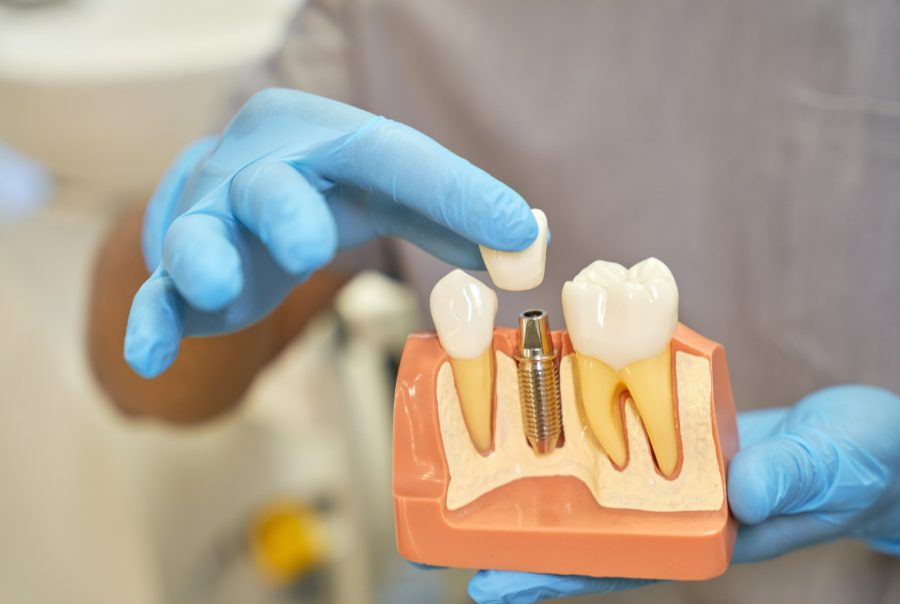Get information about implant treatment with the explanation of specialist dentist Merve Özkan Akagündüz.
Dental Implant Treatment

Implant Treatment, Doredent İstanbul
Titanium screws that replace teeth lost due to various reasons and serve as tooth roots are called implants. The implant acts as a tooth root and provides chewing function with implant-supported dentures. The aim here is for the patient to continue his life without experiencing loss of chewing function and aesthetics.
Implant treatment does not harm bone tissues. On the contrary, the level of bone tends to decrease over time in areas where teeth have been lost, and implants can prevent this bone resorption by restoring function to the area.
For implant treatment, bone development must be complete, which is why implants are not applied to individuals under the age of 18. For an implant to be placed, the bone structure must be healthy and of sufficient size. If the bone is too narrow or lacks sufficient height for implant placement, additional operations such as bone grafting and sinus lifting may be performed to make the bone structure suitable for the implant.
Implant treatments can also be applied to individuals who are completely toothless. Depending on the patient’s bone tissue, fixed or removable prosthetic options on implants are available. This prevents individuals with complete toothlessness from relying on constantly shifting removable prostheses. Even two implants placed in one jaw with removable prostheses significantly increase the patient’s comfort.
In today’s conditions, implant treatment can be easily performed under local anesthesia without the patient feeling any discomfort. If you have experienced tooth loss for any reason, it is beneficial to consult a specialist for implant treatment without delay.
How Is Implant Treatment Performed?
Before a patient can undergo implant treatment, their overall health status must be assessed to determine their suitability for the surgical procedure. A clinical oral examination and panoramic X-rays are used to evaluate the current situation. Then, the number of implants, the suitability of the areas for implant placement, the type of prosthesis to be used, and the patient’s expectations are determined.
All records taken from the patient are evaluated, and an implant plan is made. 3D imaging methods may also be utilized for this planning. After the necessary preparations, implants are mainly applied under local anesthesia. Depending on the joint decision of the patient and the doctor, general anesthesia or sedation methods may also be used.
Implant applications can be performed with or without stitches. Stitched applications are more commonly preferred. In this method, the gum is cut with a scalpel after anesthesia. Then, a cavity is created in the bone with a drill where the implant will be placed. The implant is inserted, and the gum is sutured closed.
In the stitchless method, after anesthesia, the gum is lifted where the diameter of the implant will be. Then, a cavity is created in the bone with a drill for the implant, and the implant is placed. A healing cap is then attached to the implant, completing the procedure.
In the stitched method, the healing cap is placed about 2-3 months after the implant procedure. This requires another round of anesthesia and lifting of the gum over the implant, constituting a second surgical procedure. However, this procedure is quite simple and easily performed.
What to Consider Before Implant Treatment?
Success in implant treatments is not solely dependent on the doctor’s knowledge and skills. The care shown by the patient regarding certain aspects before and after the implant treatment is also very important.
The most crucial aspect is oral hygiene. It is essential to maintain regular and effective oral hygiene, not just through brushing and using toothpaste. Using dental floss, interdental brushes, tongue scrapers, and occasionally mouthwashes is also important.
Having a smoking habit is a disadvantage for individuals receiving an implant. It is recommended to quit this habit at least two weeks before the treatment.
Another important consideration is ensuring that the implant is patented. You can obtain information about this from your doctor during the pre-procedure consultations.
What to Consider After Implant Treatment?
After implant placement, certain precautions should be taken:
- The gauze given to the patient should be bitten for approximately 30 minutes. Cotton or tissues should not be used instead.
- It’s advisable to avoid eating until the effects of anesthesia wear off.
- Swelling resulting from the operation can be alleviated with a cold compress applied to the affected area.
- Avoid spitting and gargling on the day of the implant procedure, as spitting can lead to bleeding and infection.
- Hot or cold foods should be avoided during the first few days after implant placement. It’s also important to refrain from smoking and consuming alcohol.
- It’s not recommended to take a very hot shower on the day of implant placement.
- The implanted area should not be tampered with.
- Medications prescribed by your dentist should be taken according to their recommendations.
- Oral hygiene should be maintained.
Duration of Implant Treatment
With advancements in implant quality and surface properties, temporary prostheses can be placed on implants immediately after insertion. The timing of placing permanent prostheses on implants depends on various factors, including the patient’s age, systemic health, bone quality, the number of implants, and the type of prosthesis planned.
After implant placement, it usually takes between 1 to 4 months for osseointegration (bone integration) to occur. This period may be longer if advanced surgical techniques are used.
The surgical duration of implant placement varies depending on the planned treatment and the type of implant used. For example, if a single implant is placed to replace a missing tooth, the procedure typically takes about 10-15 minutes.
To learn about a treatment plan and process that meets your expectations, it’s essential to consult with a specialist dentist.
Stages of Implant Treatment
Implant treatment is a meticulous process that should be carried out carefully. The stages of this process include:
- Clinical Evaluation: Before starting treatment, a comprehensive evaluation of the patient’s general health, medication use, oral hygiene, number and distribution of missing teeth, and patient expectations is conducted.
- Radiological Evaluation: This stage focuses on the patient’s bone tissue. Although panoramic X-rays are prioritized, three-dimensional tomographic images may also be used. X-ray examinations are conducted to determine the planned treatment based on clinical evaluation.
- Implant Planning: Based on clinical and radiological evaluations, decisions regarding implant placement site, implant diameter and dimensions, and the number of implants are made.
- Surgical Procedure: Local anesthesia is administered to the patient for the insertion of implants into the bone. After the necessary waiting period, the surgical procedure is performed. The patient is provided with a prescription and given necessary instructions post-surgery.
- Healing Process: This is the expected period for the implant to integrate with the bone after insertion. The duration of this process usually ranges from 1 to 4 months, depending on the patient’s overall health and bone quality.
- Prosthesis Placement: After the healing process is complete, the final stage involves the fabrication of the prosthesis that will be placed on the implant. Custom-designed fixed or removable prostheses undergo various laboratory processes to achieve the desired outcome. At the end of this stage, the patient regains the chewing and aesthetic functions they desired.
Implant Treatment in Cases of Bone Insufficiency
For implants to fulfill their function of replacing lost teeth and remain in the mouth without problems for many years, adequate fusion with the bone is essential. Therefore, sufficient bone tissue is naturally required. In our clinics, we often encounter many patients who want to have implants but have concerns in this regard.
Significant decreases in bone levels are commonly encountered after prolonged periods of tooth loss. In general, we do not encounter problems related to bone levels in implants placed after tooth loss. Therefore, it is best to start implant treatment as soon as possible after tooth extraction.
With advancements in technology, various surgical procedures are available to address bone loss in cases of bone insufficiency. Among these procedures are sinus lifting operations, bone graft applications, and others. In some cases, the option of zygomatic implants is also considered. Zygomatic implants are much larger than traditional implants, with lengths ranging from 30 to 50 mm. These implants are placed inside the cheekbone when there is no bone, and they can be the sole option in cases of advanced bone loss.
Merve Özkan Akagündüz
I was born in Edirne in 1988. In 2007, I began my master’s degree in Dentistry at Istanbul University (Çapa) Faculty of Dentistry and graduated in 2012.
In 2014, I started my specialization in the Department of Orthodontics at Süleyman Demirel University Faculty of Dentistry. In 2019, I earned the title of Orthodontist and was appointed to Çorlu ADSM, where I worked as an Orthodontic Specialist Dentist from 2019 to 2022.
As of 2024, I have been continuing my practice in my own clinic.








